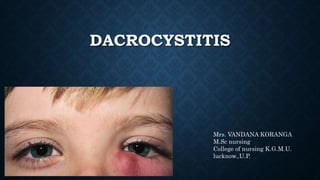
ppt.DACROCYSTITIS.pptx
- 1. DACROCYSTITIS Mrs. VANDANA KORANGA M.Sc nursing College of nursing K.G.M.U. lucknow.,U.P.
- 2. DEFINITION Dacryocystitis is inflammation of the lacrimal sac which typically occurs secondarily to obstruction within the nasolacrimal duct and the resultant backup and stagnation of tears within the lacrimal sac.
- 4. ETIOLOGY The etiology of dacryocystitis is typically due to a nasolacrimal duct obstruction (NLDO). This can further be categorized into duration (acute versus chronic) and onset (congenital and acquired causes). Acute and chronic refer to the duration of current symptoms, with acute usually being a time frame less than three months. 1-Acute dacryocystitis usually requires systemic antibiotic therapy prior to intervention for the NLDO. In the United States, likely culprits are Staphylococcus aureus, B hemolytic Streptococcus, and Haemophilus influenzae in children. In adults, the more likely causative microorganisms include Staphylococcus epidermidis, Staphylococcus aureus, Streptococcus pneumoniae, and Pseudomonas aeruginosa. 2-Chronic dacryocystitis typically presents with less inflammatory signs and requires surgical therapy for the underlying cause.
- 5. 3- CONGENITAL AND ACQUIRED REFER TO THE ONSET AND CAUSE OF THE NLDO, WHICH GUIDES THE TREATMENT ALGORITHM. CONGENITAL FORMS OF DACRYOCYSTITIS ARE TYPICALLY DUE TO OBSTRUCTION OF THE VALVE OF HASNER, LOCATED IN THE DISTAL PORTION OF THE NASOLACRIMAL DUCT. IF AMNIOTIC FLUID IS NOT EXPELLED FROM THE NASOLACRIMAL SYSTEM A FEW DAYS FOLLOWING DELIVERY, IT CAN BECOME PURULENT, LEADING TO NEONATAL DACRYOCYSTITIS. 4- ACQUIRED CAUSES OF DACRYOCYSTITIS I] AGING II] SYSTEMIC DISORDERS (LIKE SARCOIDOSIS), TRAUMA (SUCH AS NASOETHMOID FRACTURES), III] SURGERIES (SUCH AN ENDONASAL PROCEDURES), NEOPLASMS, CERTAIN MEDICATIONS (SUCH AS TIMOLOL, PILOCARPINE, IDOXURIDINE, AND TRIFLURIDINE).
- 6. SIGN AND SYMPTOMS • pain. • erythema. • edema over the medial canthus and the area overlying the lacrimal sac at the inferomedial portion of the orbit. • The redness can extend to involve the bridge of the nose. • Purulent material can sometimes be expressed from the puncta and tearing may be present. • In cases of chronic dacryocystitis, excessive tearing and discharge are the most common symptom. • Pus and musus • fever
- 7. RISK FACTORS • The risk factors for dacryocystitis are varied but are almost always related to nasolacrimal duct obstruction. • Females are at greater risk due to their narrower duct diameter as compared to males • Older age leads to narrowing of the punctual openings, slowing tear drainage • Dacryoliths; often idiopathic, a collection of shed epithelial cells, lipids, and amorphous debris within the nasolacrimal system • Nasal septum deviation, rhinitis and turbinate hypertrophy • Damage to the nasolacrimal system due to trauma of the nasoethmoid region or endoscopic/endonasal procedures • Neoplasm within the nasolacrimal system • Systemic disease such as granulomatosis with polyangiitis (GPA; formerly Wegener’s granulomatosis), sarcoidosis, and Systemic Lupus Erythematosus (SLE), or lacrimal sac tumors • Medications such as timolol, pilocarpine, idoxuridine, and trifluridine
- 8. PATHOPHYSIOLOGY occurs secondary to obstruction of the nasolacrimal duct. Obstruction of the nasolacrimal duct leads to stagnation of tears in a pathologically closed lacrimal drainage system stagnated tears providing a favorable environment for infectious organisms. The lacrimal sac will then become inflamed leading to the characteristic erythema and edema at the inferomedial portion of the orbit.
- 9. COMPLICATIONS • An acute infection can become chronic if you don’t treat it quickly enough. In babies with congenital dacryocystitis, the infection can spread into the eye socket. This can lead to life-threatening complications such as: • brain abscess, a collection of pus in the brain • meningitis, or inflammation of the membranes around the brain and spinal cord • sepsis, a body-wide inflammatory response caused by infection
- 10. DIAGNOSIS • medical history. • Accessing the eye for visible signs of dacryocystitis, such as swelling or redness. • Pressing on the lacrimal sac to see if pus comes out. • Collecting a sample of the pus to test for bacteria. • Doing an eye exam. • Taking a sample of any discharge to culture in the lab to find out which germ is causing the infection. • Taking a blood sample to check the level of white blood cells.
- 11. MANAGEMENT • Antibiotics, either oral or intravenous, to kill the bacteria that caused the infection • Antibiotic eye drops or ointment to prevent further infection • Warm compresses and gentle massage to relieve symptoms • Surgery to clear the blocked tear duct, usually after the infection has resolved
- 12. NURSING MANAGEMENT Good hand washing and eyelid hygiene. Application of antibiotic ointment. Treatment usually consists of warm soaks to help promote drainage.